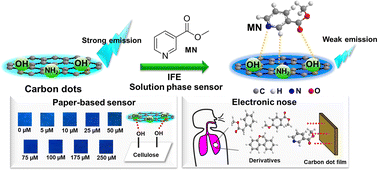Dual-function sensors based on carbon dots derived from corncobs for methyl nicotinate detection in solution and vapor phases†
Abstract
Tuberculosis (TB) is a deadly disease and needs a fast, cheap, and effective method of detection at an early stage. Methyl nicotinate (MN) is an important TB biomarker, but there are only a few reports on MN sensing. In this study, fluorescence-based sensors and optical electronic nose sensors from carbon dots (CDs) were developed for the highly sensitive and selective detection of MN. They were able to detect MN in the solution phase via the inner filter effect (IFE) and strong π–π interactions between the pyridine ring and the CDs. The limit of detection was found to be dependent upon the excitation wavelength and concentration of CDs. The use of 0.05 mg mL−1 CDs and 260 nm excitation provided the best linearity range of over 5–500 μM and the lowest detection limit of 3 nM. The CDs showed excellent photostability and good selectivity towards MN in the presence of several interferences. This work demonstrated the practical use of the CDs when tested in MN spiked biological samples, with 98.8–102.9% recovery percentage. The fabrication of reusable paper-based sensors was also demonstrated. The CD thin film integrated in the optical electronic nose could sense MN vapor and distinguish MN from other biomarkers. The CDs developed in this work can be potentially used as dual-mode sensors for early TB detection.



 Please wait while we load your content...
Please wait while we load your content...